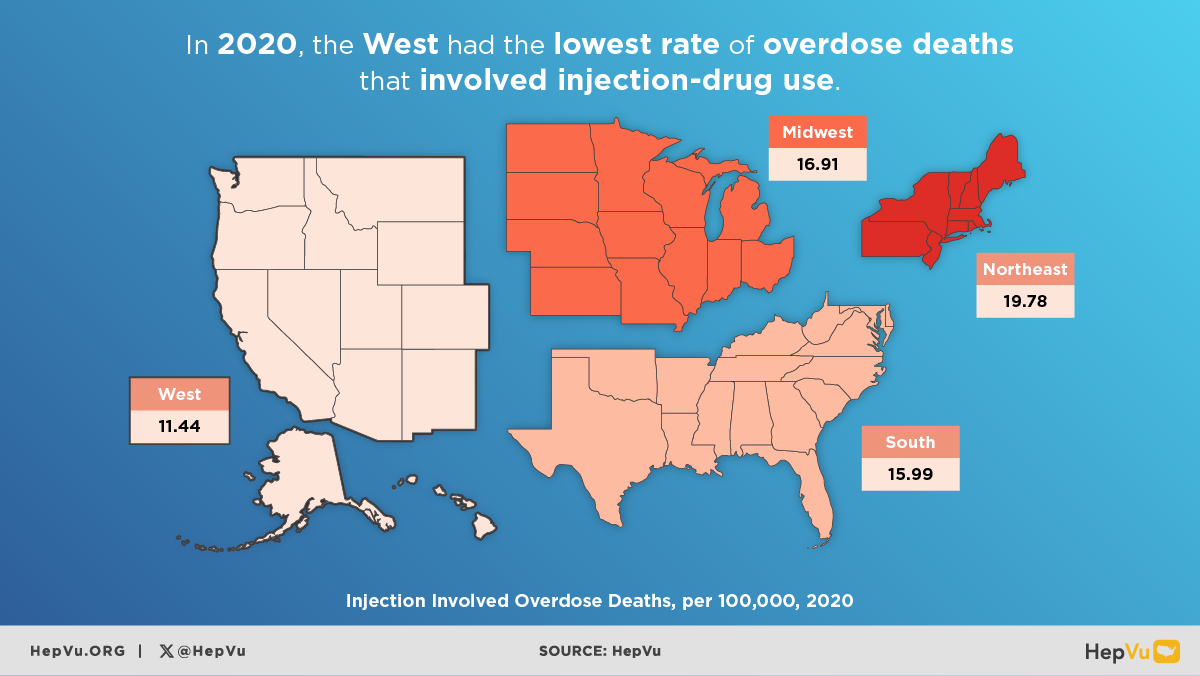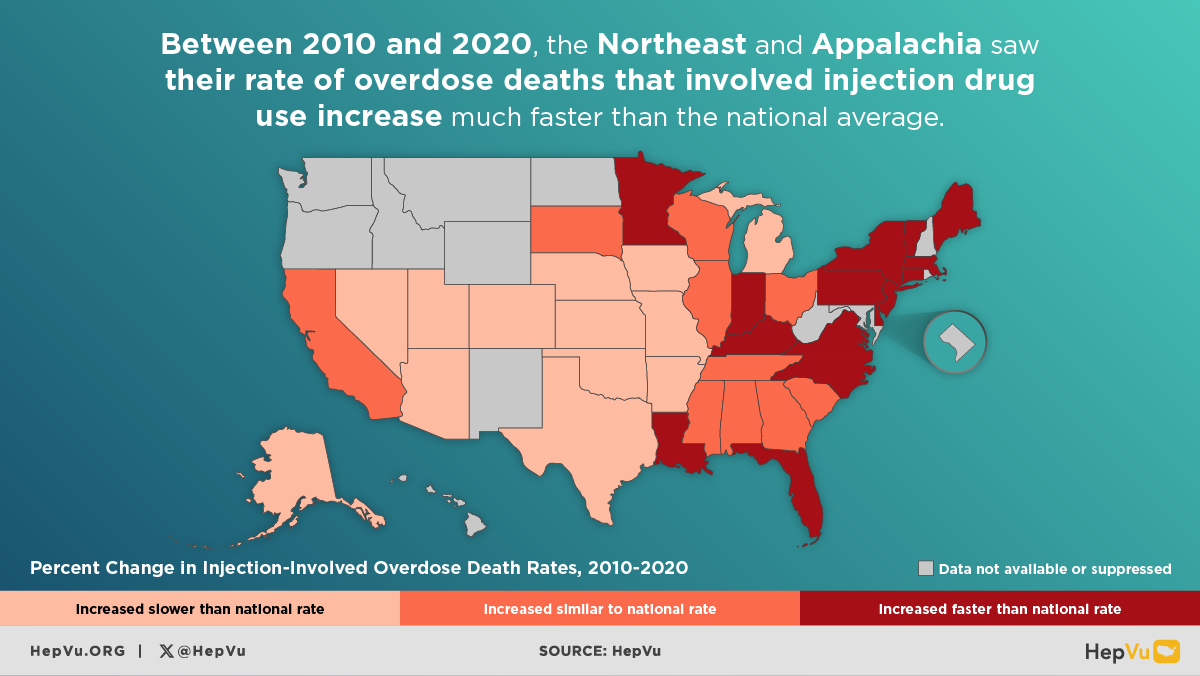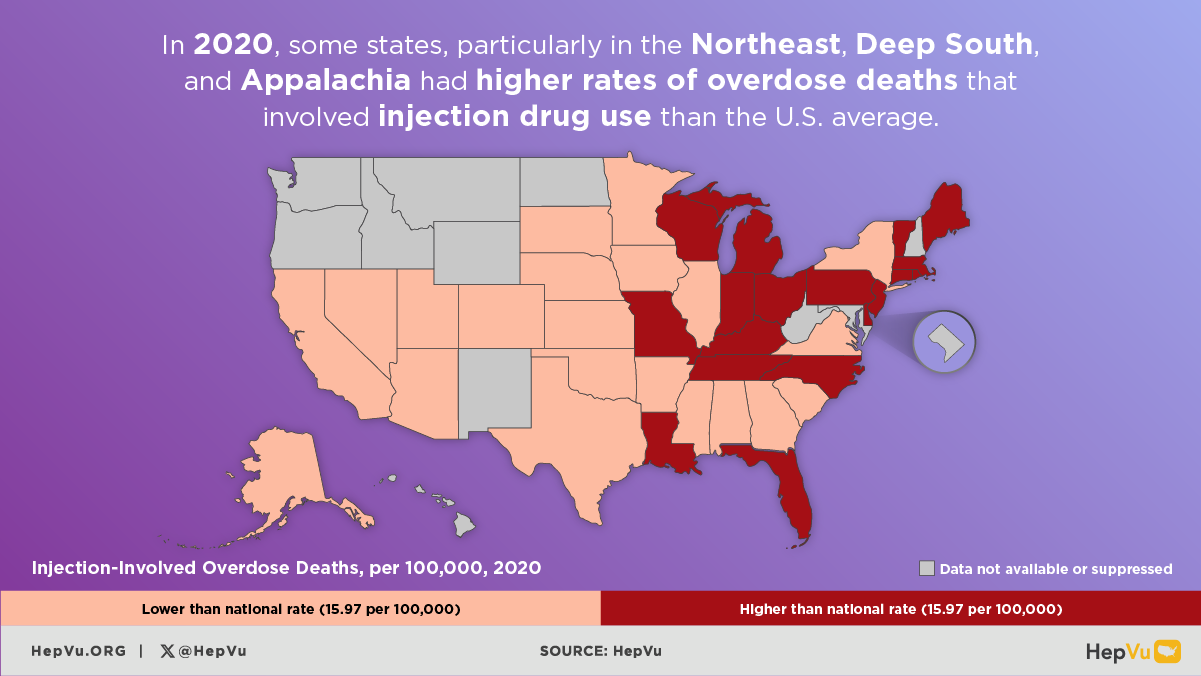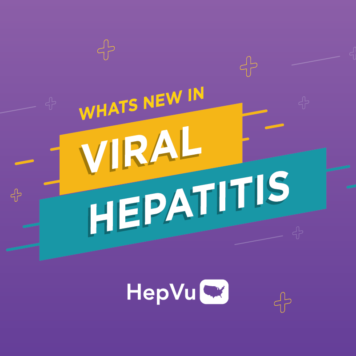New data shows the opioid epidemic’s ongoing increase of deaths related to injection drug use at the state-level
State-level injection-involved overdose mortality data is critical to understanding the extent of the viral hepatitis epidemic and targeting funding interventions
Washington, DC – Today, HepVu — a leading organization that visualizes viral hepatitis data and makes it widely available—released data on injection-involved overdose mortality—or the percentage of overdose deaths that were injection-involved—at the state level in 2020. The data show that while injection drug overdose mortality has increased dramatically nationwide, this trend is particularly evident in certain states. These findings are based on the paper “Estimated Number of Injection-Involved Overdose Deaths in US States from 2000 to 2020: Secondary Analysis of Surveillance Data,” published on April 5, 2024, in JMIR Public Health and Surveillance.
The opioid crisis is one of the greatest public health challenges facing the U.S., causing an unprecedented surge in overdose deaths, and fueling the rapid rise in new Hepatitis C cases from injection drug use in communities across the country. The number of new Hepatitis C cases more than doubled from 2012 to 2019, largely as a consequence of the rise in injection drug use.
A better understanding of state-level trends in injection-involved mortality can inform the prioritization of public health strategies that aim to reduce overdose mortality and prevent downstream consequences of injection drug use—as well as target prevention programs and interventions aimed at preventing and treating Hepatitis C.
“We know that the drug overdose epidemic is a dangerous and growing public health threat across the country. As injection-involved mortality rates have skyrocketed, new Hepatitis C infections have also increased. Without a robust viral hepatitis surveillance system, U.S. jurisdictions lack the full picture of the viral hepatitis epidemic—which is why these state-level data are so critical to target prevention programs and intervention for public health consequences of injection drug use, such as viral hepatitis and HIV infections,” said Dr. Eric Hall, PhD, MPH Assistant Professor, Oregon Health and Science University, principal author of the study and HepVu fellow.
Key Findings Include:
- Between 2010 and 2020, the Northeast and Appalachia saw their rate of overdose mortality deaths that involved injection-drug use increase much faster than the national average.
- Between 2010 and 2020, Kentucky, Massachusetts, Florida, Georgia, and Indiana had the highest percent increases in the proportion of overdose deaths that involved injection-drug use.
- In 2020, Massachusetts, Pennsylvania, Indiana, Kentucky, and Alaska had the highest proportion of overdose deaths that involved injection drug use.
- In 2020, the West had the lowest rate of overdose deaths that involved injection-drug use.
This new paper takes a unique scientific approach to better understand how injection-related behavior might be changing in different parts of the country. According to CDC, the rate of new Hepatitis C cases among young people 18–40 years has increased steadily each year since 2013 to 2.8 cases per 100,000 population in 2019. Injection-drug use is the most common risk reported for persons with new Hepatitis C diagnoses, and increases in Hepatitis C incidence, particularly among persons aged 18–40 years, have occurred alongside increases in injection-drug use.
Surveillance:
In November, HepVu partnered with the National Alliance of State & Territorial AIDS Directors (NASTAD) to release the second annual report showing that health departments in the U.S. lack the funding and resources needed to effectively evaluate the spread of viral hepatitis, thus limiting their ability to proactively target prevention programs to prevent further spread of hepatitis C and death from injection drug overdose. These data on injection-involved overdose mortality highlight the importance of robust surveillance data in helping to inform earlier interventions.
Updated HepVu Data on Opioids and Hepatitis C Mortality:
HepVu’s updated maps include: 2021 county- and state-level opioid prescription and overdose mortality, 2021 state-level pain-reliever misuse, 2021 Hepatitis C mortality, as well as 2020 injection-involved overdose state maps and 2020 Hepatitis C mortality county maps, containing data only available on HepVu.
According to the Centers for Disease Control (CDC), the number of deaths due to opioid use disorder has increased sharply since 2015. Relatedly, new viral hepatitis infections are also on the rise due to injection-drug use. HepVu maps opioid indicators alongside Hepatitis C data to help researchers, policymakers, and the public better understand these overlapping epidemics.
Recent years have seen many changes in America’s hepatitis C epidemic, including the development of treatments that can cure infection, thereby preventing long-term catastrophic consequences of hepatitis C and also reducing spread of the virus from untreated persons. When made fully available, these new treatments can blunt mortality rates both nationally and locally. But health departments still need robust surveillance systems in order to monitor trends in new infections and to identify those populations who are not benefiting from access to curative treatment.
About HepVu:
HepVu is presented by Emory University’s Rollins School of Public Health in partnership with Gilead Sciences, Inc. HepVu continues to advance its mission to make viral hepatitis data widely available, easily accessible, and locally relevant to inform public health decision-making. The site aims to provide researchers, policymakers, and community members with a more comprehensive understanding of these epidemics at the local-, state-, and national-level.
To learn more about HepVu’s data and sources, see our FAQ and Data Methods.









